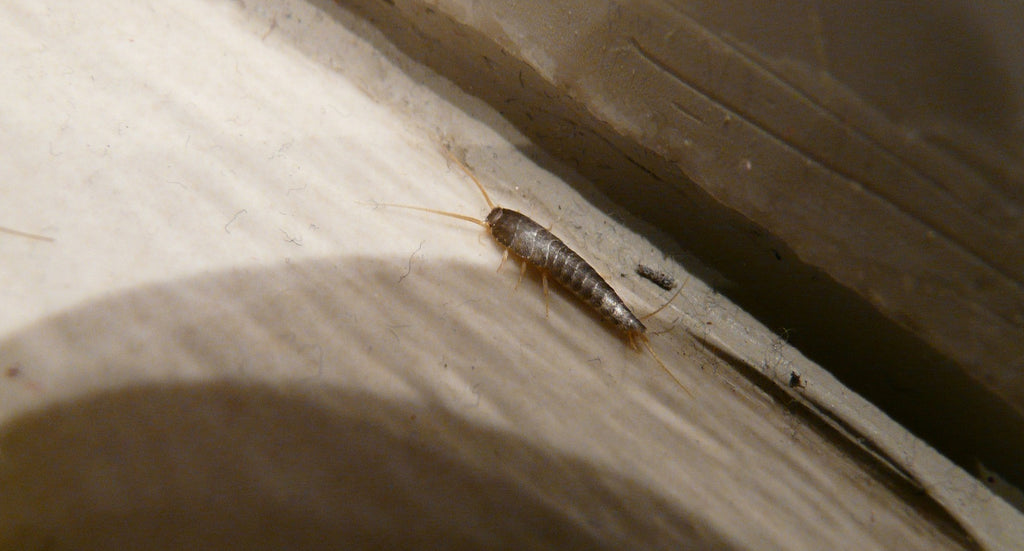Get Rid of Silverfish in 4 Easy Steps

Guide To Silverfish Control
Let's face it...silverfish are just plain creepy. Nobody likes them, everybody hates them. And when they come, they usually start showing up in unsettlingly large numbers. So what's the best way to battle these slithery invaders? Pest Control Everything has developed a plan to help you Get Rid of Silverfish in 4 Easy Steps.
Step 1: Remove Silverfish by Vacuuming
 As with many insect infestations, immediate pest removal is often an excellent first step in pest control. Vacuuming instantly reduces silverfish populations in an environment, jump-starting your silverfish remediation program. When vacuuming, use a vacuum with a disposable bag so that you can discard the contents (and the silverfish) in a sealable container outside the home upon completion. Remember that the largest concentrations of silverfish are going to be in dark, out of the way areas like cracks and crevices or inside wall voids. Using a want extension, seek to vacuum into as many of these silverfish harborage areas as possible, knowing that you are unlikely to get them all. The mission here is to remove as many live silverfish as possible in order to move forward with other parts of the silverfish control program. Vacuuming can and should be done throughout the duration of your remediation program as well.
As with many insect infestations, immediate pest removal is often an excellent first step in pest control. Vacuuming instantly reduces silverfish populations in an environment, jump-starting your silverfish remediation program. When vacuuming, use a vacuum with a disposable bag so that you can discard the contents (and the silverfish) in a sealable container outside the home upon completion. Remember that the largest concentrations of silverfish are going to be in dark, out of the way areas like cracks and crevices or inside wall voids. Using a want extension, seek to vacuum into as many of these silverfish harborage areas as possible, knowing that you are unlikely to get them all. The mission here is to remove as many live silverfish as possible in order to move forward with other parts of the silverfish control program. Vacuuming can and should be done throughout the duration of your remediation program as well.
Step 2: Silverfish Place Packs
 After vacuuming, put out several silverfish place packs, such as the Dekko Silverfish Paks, throughout the impacted areas in locations inaccessible to children and pets. These place packs are an economical and effective way to easily control silverfish populations, as the boric acid acts as a lethal toxicant upon ingestion. Simply place 2 or 3 packs in affected areas such closets, drawers, bookcases, basements, attics, and other areas where silverfish may be harboring. Place packs should be replaced every 3 months or so for ongoing protection and control.
After vacuuming, put out several silverfish place packs, such as the Dekko Silverfish Paks, throughout the impacted areas in locations inaccessible to children and pets. These place packs are an economical and effective way to easily control silverfish populations, as the boric acid acts as a lethal toxicant upon ingestion. Simply place 2 or 3 packs in affected areas such closets, drawers, bookcases, basements, attics, and other areas where silverfish may be harboring. Place packs should be replaced every 3 months or so for ongoing protection and control.
Step 3: Silverfish Traps & Monitors
 In addition to the silverfish place packs that function upon being eaten, insect glue boards or sticky traps can serve as an additional tool to speed up the silverfish elimination process. Place insect monitors along walls, beneath sinks and cabinets, and in other areas where silverfish may be likely to harbor or travel. Remove and replace silverfish monitors as necessary. In addition to serving as a means of silverfish removal, these traps will also become a valuable tool in helping you determine any remaining silverfish presence over time. After several months without capturing any silverfish, it may be reasonable to conclude that the silverfish problem has been resolved, at least temporarily. You may wish to continue using monitors moving forward to detect any reintroduction of silverfish and resume additional efforts before their populations have an opportunity to regenerate.
In addition to the silverfish place packs that function upon being eaten, insect glue boards or sticky traps can serve as an additional tool to speed up the silverfish elimination process. Place insect monitors along walls, beneath sinks and cabinets, and in other areas where silverfish may be likely to harbor or travel. Remove and replace silverfish monitors as necessary. In addition to serving as a means of silverfish removal, these traps will also become a valuable tool in helping you determine any remaining silverfish presence over time. After several months without capturing any silverfish, it may be reasonable to conclude that the silverfish problem has been resolved, at least temporarily. You may wish to continue using monitors moving forward to detect any reintroduction of silverfish and resume additional efforts before their populations have an opportunity to regenerate.
Step 4: Silverfish Moisture Reduction
 Because silverfish tend to flourish in areas of high humidity, silverfish populations are often most pervasive in bathrooms, basements, attics, and similar areas where moisture content is higher than average. When silverfish infestations are advanced, it is sometimes necessary to consider reducing the moisture content in the impacted areas. Provided there are no structural deficiencies such as roof or plumbing leaks, a dehumidifier may be a practical option to reduce the relative humidity levels within the structure. Many space dehumidifiers are available for an affordable cost. It should not be overlooked that most instances of extreme silverfish populations happen in combination with high areas of moisture.
Because silverfish tend to flourish in areas of high humidity, silverfish populations are often most pervasive in bathrooms, basements, attics, and similar areas where moisture content is higher than average. When silverfish infestations are advanced, it is sometimes necessary to consider reducing the moisture content in the impacted areas. Provided there are no structural deficiencies such as roof or plumbing leaks, a dehumidifier may be a practical option to reduce the relative humidity levels within the structure. Many space dehumidifiers are available for an affordable cost. It should not be overlooked that most instances of extreme silverfish populations happen in combination with high areas of moisture.
Time To Consult a Professional Silverfish Exterminator?
There are more than 20,000 licensed pest control companies in the United States for a reason, and there is no shame in letting the pros do what they do best. Click here to find professional exterminators in your area now.
